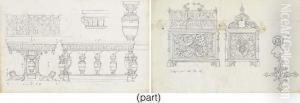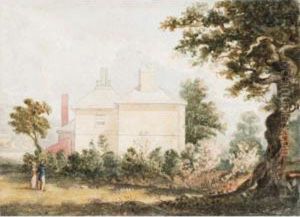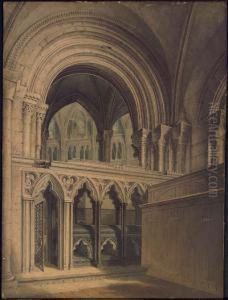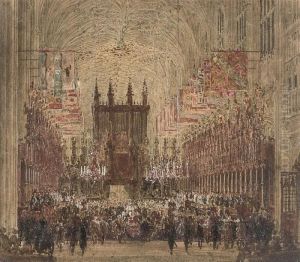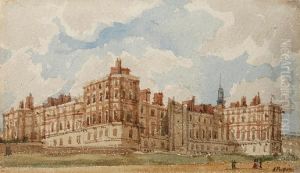Augustus Northmore Welby Pugin Paintings
Augustus Northmore Welby Pugin, born on March 1, 1812, in Bloomsbury, London, was a pivotal figure in the Gothic Revival movement in architecture and design. He was the son of Auguste Pugin, a French draftsman and designer who had emigrated to England, and Catherine Welby. Pugin's upbringing in a creative environment, combined with his education, which included a stint at Christ's Hospital school, deeply influenced his later work and philosophies. Despite his relatively short life, Pugin's legacy in architecture and design is monumental, marked by his fervent advocacy for the revival of medieval Gothic architecture as a means to promote spiritual and moral values.
Pugin's career began in earnest at the age of 15, when he started working for his father, contributing to architectural drawings and designs. His talents were recognized early, and by his late teens, he was already making significant contributions to the field of architecture. Pugin's devout conversion to Roman Catholicism in 1835 deeply influenced his architectural philosophy, intertwining his religious beliefs with his design principles. He saw Gothic architecture as an expression of Christian values, in stark contrast to what he perceived as the moral decay associated with the mechanization and industrialization of the 19th century.
Throughout his career, Pugin designed a range of buildings, from churches and cathedrals to schools and private residences. Notably, he collaborated with Sir Charles Barry on the design of the Houses of Parliament in London, one of the most iconic examples of Gothic Revival architecture. Pugin was responsible for much of the building's intricate interior design and detailing, including the design of the famous clock tower, known as Big Ben. Beyond architecture, Pugin was also a prolific designer of furniture, stained glass, and metalwork, advocating for the unity of all arts within the framework of Gothic design principles.
Pugin's publications, including "Contrasts" (1836) and "The True Principles of Pointed or Christian Architecture" (1841), were influential texts that argued for the revival of medieval Gothic architecture and its moral and spiritual superiority over other styles. His writings and designs sparked a widespread revival of Gothic architecture throughout the British Isles and beyond, influencing generations of architects and designers.
Despite his considerable achievements, Pugin's life was marred by personal struggles, including bouts of mental illness and overwork. He died on September 14, 1852, at the age of 40, in Ramsgate, Kent, where he had spent his final years. Pugin was buried in St Augustine's Church, a building he had designed and considered his own spiritual haven. His legacy endures in the many buildings and designs he left behind, as well as in his profound influence on the Gothic Revival movement and architectural thought.

